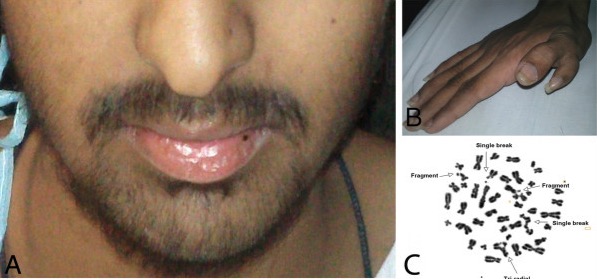Playlist
Show Playlist
Hide Playlist
Aplastic Anemia – Hematopoietic Malignancies and Aplastic Anemia
-
Slides Other haemopoietic malignancies and aplastic anaemia.pdf
-
Reference List Hematology.pdf
-
Download Lecture Overview
00:02 Finally, let's finish with another important hematological disease, although not a malignant disorder. 00:10 This is aplastic anemia. 00:13 And this is a rare condition. 00:15 But it's characterized by low blood counts due to the fact that there's a reduction in cellularity of the bone marrow. 00:24 Just look at that slide on the right, that is a bone marrow biopsy, a terrifying biopsy of the bone marrow. 00:33 And you can see there are too many holes in that, too many fat cells, not enough hemopoiesis. 00:43 Now, why would this arise? Well, in adults, a probably arises we think, because the immune system is somehow damaging the stem cells within the bone marrow and reducing their numbers. 00:58 Just to get our terms correct, bone marrow may be actually hypoplastic that means a reduced cellularity or completely aplastic empty. 01:12 Out of interest, that slide on the right I would call hypoplastic and you can see there is still some hematopoiesis there, but it's reduced from what it normally would be. 01:23 Now then, let's think about why aplastic anemia may arise. 01:30 Now, occasionally, we see this in children. 01:34 And this usually arises because of inherited abnormalities that they've got due to damage genes from their mother, or father. 01:42 Fanconi Anemia, is one of the most common of these collectively rare disorders. 01:49 And you'll see, on the top right, some of the skeletal abnormalities in the digits that you can see in Fanconi Anemia. 01:58 And below that some of the otter skin pigmentation that you may also see here. 02:05 But in adults, aplastic anemia usually arises out of the blue, as we call idiopathic. No obvious reason why. 02:15 Although it may occasionally follow episodes of hepatitis or an unusual reaction to drug therapy. 02:24 We make the diagnosis by doing that all important bone marrow trephine, which shows the empty bone marrow lacking in stem cells. 02:36 Then what can we do about it? Well, treatment has two major components. 02:43 One is supportive therapy. 02:45 We keep the patient alive despite the fact that their bone marrow is not working properly. 02:50 We can transfuse red cells. We can transfuse platelets. 02:56 Neutrophils are more challenging, and we don't usually do that and we try to control infection with antibiotics and antifungal agents. 03:07 A specific treatment aims to reverse the process of aplasia and start the bone marrow being produced again. 03:17 And here we tend to use immune suppression with a drug is called anti-lymphocyte globulin. 03:25 This is an unusual product in which human lymphocytes are injected into an animal, perhaps a horse, or rabbit even. 03:34 And those animals will make antibodies against the human lymphocytes, which we can purify and give to patients. 03:41 And you can imagine that that reduces the lymphocytes in the patient, and it's quite an immune suppressive therapy. 03:50 It's been proven to be pretty highly effective in patients with aplastic anemia. 03:56 We often combine this with a drug called cyclosporine. 04:00 That's an immune suppressant drug as well, and is often used in people who have had a kidney transplant to reduce organ rejection. 04:10 In patients with moderate disease, that would be the approach you would take if they had a very severe aplastic anemia with very low blood counts. 04:19 You may also think of a bone marrow transplant an allogeneic bone marrow transplant from another person and that can be highly effective in people with severe disease. 04:34 So in summary. 04:36 What we've seen in this lecture is that a wide variety of disorders may develop within the hemopoietic system. 04:43 Myelodysplasia results from a wide range of mutations that damage the ability of hematopoietic stem cells to produce functional and effective blood cells. 04:55 Myeloproliferative diseases have a well defined genetic basis and lead to over active bone marrow, often with clinical splenomegaly. 05:05 And myeloma is a malignant disease of plasma cells leads to bone damage, and paraprotein which itself can cause a range of clinical problems. 05:15 Finally, aplastic anemia is a rare but serious condition that may result from stem-cell failure perhaps as a result of an inherited abnormality or from autoimmune damage. 05:30 Thanks for watching this lecture on hemopoietic malignancy.
About the Lecture
The lecture Aplastic Anemia – Hematopoietic Malignancies and Aplastic Anemia by Paul Moss, PhD, OBE, FMed, FRCPath is from the course Hematologic Disorders.
Included Quiz Questions
Which inherited disorder is MOST likely present in a child with a CBC showing: Hb 7 g/l, WBC 0.2, and platelets 30?
- Fanconi anemia
- Cystic fibrosis
- Thalassaemia
- Sickle cell anemia
- Muscular dystrophy
Which of the following is used in the diagnosis of aplastic anemia?
- Bone marrow trephine biopsy
- Bone marrow aspiration
- Peripheral smear
- Genetic analysis
- PCR
Which of the following is NOT used in the treatment of aplastic anemia?
- Plasmapheresis
- Cyclosporine
- Allogenic stem cell transplant
- Anti-lymphocyte globulin
- Transfusion of red cells and platelets
Customer reviews
5,0 of 5 stars
| 5 Stars |
|
1 |
| 4 Stars |
|
0 |
| 3 Stars |
|
0 |
| 2 Stars |
|
0 |
| 1 Star |
|
0 |
1 customer review without text
1 user review without text




